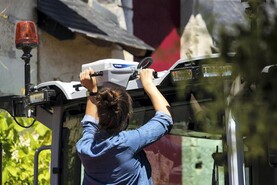The minimum wage in the state of California is going up in stages from $10.50/hour in 2018 to $15/hour by 2021.
The knock-on effect of this is huge for a state that produces a large amount of hand-harvested crops.
The issue is compounded by the fact that fewer and fewer labourers are coming across the Mexican border.
Those who have come to work in the US spend some time on farms and go into “nicer” jobs once they become legal.
Some growers have reportedly moved operations to Mexico where wages are around $10/day.
Californian farmers are worried that crops produced cheaply in Mexico will displace their product on the shop shelf.
Listen to "Battling a labour shortage in California" on Spreaker.
“Labour is a huge challenge right now. The economy is booming. It is a challenge to find labour in competition with building and restaurant work. The farmer is spending more time on work and less on management,” said Paul Sousa from Western Dairies. “We need to control our borders, we need to know who is coming in to the United States. But we need a balance of having available workers and be able to secure our borders.”

Harvesting carrots at Grimmway Farms in Bakersfield, California.
For every dollar that the minimum wage goes up, it costs the largest carrot producers in the world, Grimmway Farms, $15m per year. Growing 35,000 acres of carrots, Grimmway has 7,000 staff as well as its field staff who are paid by the hour.
Boggiatto Produce
Boggiatto Produce in Salinas, California, produces 750,000 boxes of Brussels sprouts a year. Across all of its sites, Boggiatto Produce covers 4,500 acres, some of which is on contract.
Production is based in Salinas from July to December. But from January to April, it is in Mexico where the climate is better for winter crops.
The US government sets the wage for the H-2A workers at $13.75/hour, which is higher than minimum wage
During sprout harvesting, four labourers are needed cutting in front of the harvester, eight people on the trailer packing sprouts into boxes, one harvester driver, two tractor drivers and a forklift driver. Most of the staff are from Mexico on the H-2A temporary work visa programme.
“They can work for a season here and earn what they would in eight years in Mexico,” Jeff Hitchcock, president and CEO of Boggiatto told the SAYFC study trip to California.
“Once they provide you with a social security number and ID, they are hireable.
"The US government sets the wage for the H-2A workers at $13.75/hour, which is higher than minimum wage.
"There is mechanisation coming in the business. We have a lettuce-thinning machine, so one driver can do what it once took 20 to do.”
The main barrier to mechanical harvesting of fresh produce seems to be plant breeding.
Mechanical harvesters need uniformity in size and ripening time for fruit or vegetables and also cannot damage the fruit. For the moment, the immigrant workforce is still in strong demand in the US.
Del Bosque Farms
Del Bosque Farms hires 300 people at harvest to hand-pick its fresh produce across 2,000 acres, half of which are melons.
“There are a few small towns in the valley but not enough people to fill the jobs,” CEO Joe Del Bosque said. “All of the big urban centres are an hour and a half away. The challenge is that these are seasonal jobs, harvest is only three and a half months. A lot of labourers come at that time and then work for another farmer, pruning, etc.”
Most agricultural work is exempt from overtime but from 2019 onwards anyone who works over 55 hours a week must be paid overtime and that is gradually moving to 40 hours.
“Why aren’t we mechanising like the processing tomatoes? They had to develop varieties that would all ripen at the same time and stay on the plant without rotting.
"They’re not what you want to eat in a salad. We are developing new melon varieties but they don’t taste the same.”
Del Bosque is moving to organic production to maintain market share and compete with cheaper produce from places such as Mexico.
He says that asparagus production has diminished in California and is nearly all in Mexico now.
Meet Fred and Ethel
Fred and Ethel (right) are reported to be the first DeLaval robotic milking machines in the state of California.
Jones Farm near Turlock put in two robots as a trial for one year. Out of the farm’s 800 cows, 100 are milked through the robots.
The farm employs five milkers, two per shift and fresh cows are milked four times a day for the first 21 days
Part of the reason for trying robots was labour but also cows’ comfort. Other farmers with robots in the US say that they get an additional 1.5 lactations/cow when using them.
At Jones Farm, each lactation is just over 400 days and the average is 2.1 lactations per cow.
The farm employs five milkers, two per shift and fresh cows are milked four times a day for the first 21 days.

Fred and Ethel are the only two DeLaval robots in the state of California.
While people used to regularly stop by looking for work, that happens less often now. People want work six days per week and regular hours.
While labour-saving is an added benefit, Jones Farm has seen better reproduction rates since the robots were installed in March and has ordered 12 more, which will be installed in stages.
The minimum wage in the state of California is going up in stages from $10.50/hour in 2018 to $15/hour by 2021.
The knock-on effect of this is huge for a state that produces a large amount of hand-harvested crops.
The issue is compounded by the fact that fewer and fewer labourers are coming across the Mexican border.
Those who have come to work in the US spend some time on farms and go into “nicer” jobs once they become legal.
Some growers have reportedly moved operations to Mexico where wages are around $10/day.
Californian farmers are worried that crops produced cheaply in Mexico will displace their product on the shop shelf.
Listen to "Battling a labour shortage in California" on Spreaker.
“Labour is a huge challenge right now. The economy is booming. It is a challenge to find labour in competition with building and restaurant work. The farmer is spending more time on work and less on management,” said Paul Sousa from Western Dairies. “We need to control our borders, we need to know who is coming in to the United States. But we need a balance of having available workers and be able to secure our borders.”

Harvesting carrots at Grimmway Farms in Bakersfield, California.
For every dollar that the minimum wage goes up, it costs the largest carrot producers in the world, Grimmway Farms, $15m per year. Growing 35,000 acres of carrots, Grimmway has 7,000 staff as well as its field staff who are paid by the hour.
Boggiatto Produce
Boggiatto Produce in Salinas, California, produces 750,000 boxes of Brussels sprouts a year. Across all of its sites, Boggiatto Produce covers 4,500 acres, some of which is on contract.
Production is based in Salinas from July to December. But from January to April, it is in Mexico where the climate is better for winter crops.
The US government sets the wage for the H-2A workers at $13.75/hour, which is higher than minimum wage
During sprout harvesting, four labourers are needed cutting in front of the harvester, eight people on the trailer packing sprouts into boxes, one harvester driver, two tractor drivers and a forklift driver. Most of the staff are from Mexico on the H-2A temporary work visa programme.
“They can work for a season here and earn what they would in eight years in Mexico,” Jeff Hitchcock, president and CEO of Boggiatto told the SAYFC study trip to California.
“Once they provide you with a social security number and ID, they are hireable.
"The US government sets the wage for the H-2A workers at $13.75/hour, which is higher than minimum wage.
"There is mechanisation coming in the business. We have a lettuce-thinning machine, so one driver can do what it once took 20 to do.”
The main barrier to mechanical harvesting of fresh produce seems to be plant breeding.
Mechanical harvesters need uniformity in size and ripening time for fruit or vegetables and also cannot damage the fruit. For the moment, the immigrant workforce is still in strong demand in the US.
Del Bosque Farms
Del Bosque Farms hires 300 people at harvest to hand-pick its fresh produce across 2,000 acres, half of which are melons.
“There are a few small towns in the valley but not enough people to fill the jobs,” CEO Joe Del Bosque said. “All of the big urban centres are an hour and a half away. The challenge is that these are seasonal jobs, harvest is only three and a half months. A lot of labourers come at that time and then work for another farmer, pruning, etc.”
Most agricultural work is exempt from overtime but from 2019 onwards anyone who works over 55 hours a week must be paid overtime and that is gradually moving to 40 hours.
“Why aren’t we mechanising like the processing tomatoes? They had to develop varieties that would all ripen at the same time and stay on the plant without rotting.
"They’re not what you want to eat in a salad. We are developing new melon varieties but they don’t taste the same.”
Del Bosque is moving to organic production to maintain market share and compete with cheaper produce from places such as Mexico.
He says that asparagus production has diminished in California and is nearly all in Mexico now.
Meet Fred and Ethel
Fred and Ethel (right) are reported to be the first DeLaval robotic milking machines in the state of California.
Jones Farm near Turlock put in two robots as a trial for one year. Out of the farm’s 800 cows, 100 are milked through the robots.
The farm employs five milkers, two per shift and fresh cows are milked four times a day for the first 21 days
Part of the reason for trying robots was labour but also cows’ comfort. Other farmers with robots in the US say that they get an additional 1.5 lactations/cow when using them.
At Jones Farm, each lactation is just over 400 days and the average is 2.1 lactations per cow.
The farm employs five milkers, two per shift and fresh cows are milked four times a day for the first 21 days.

Fred and Ethel are the only two DeLaval robots in the state of California.
While people used to regularly stop by looking for work, that happens less often now. People want work six days per week and regular hours.
While labour-saving is an added benefit, Jones Farm has seen better reproduction rates since the robots were installed in March and has ordered 12 more, which will be installed in stages.








 This is a subscriber-only article
This is a subscriber-only article









SHARING OPTIONS: